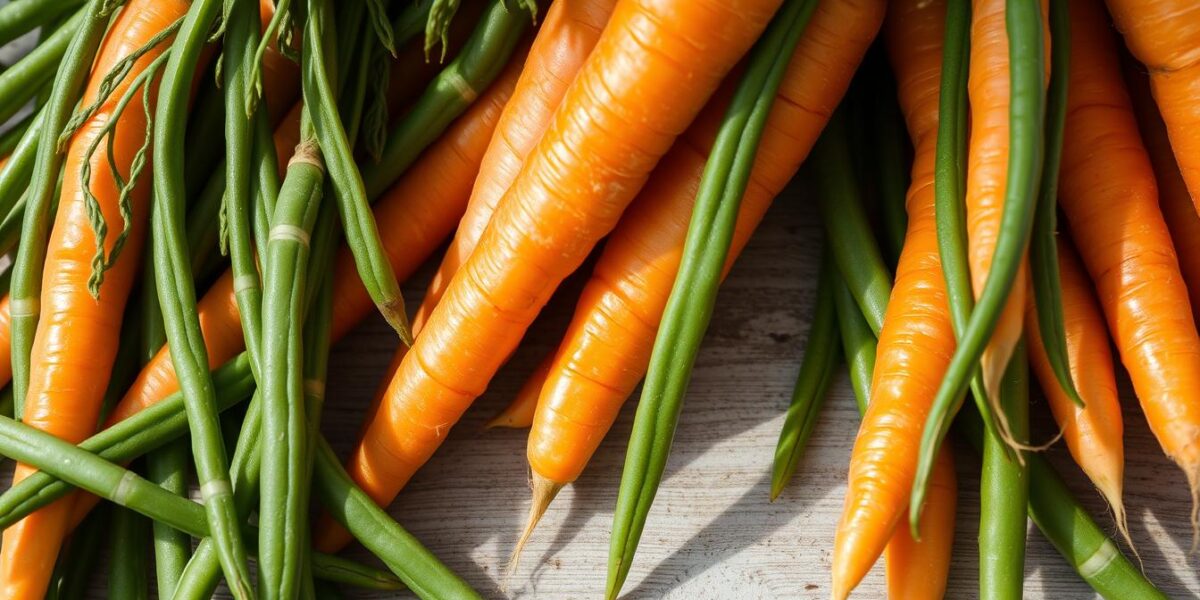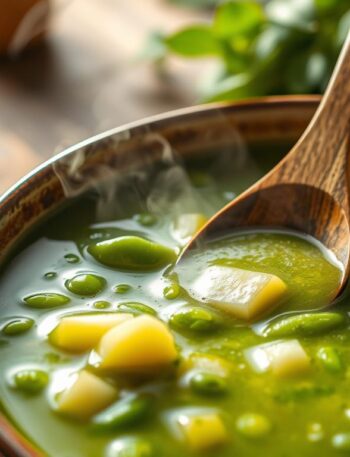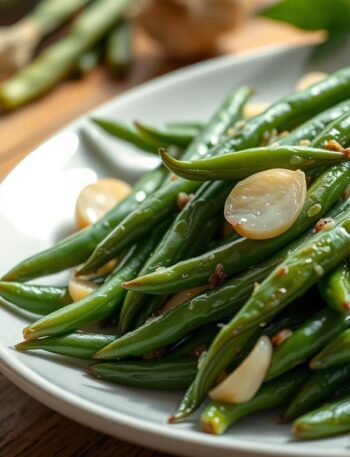Carrots and green beans are a vibrant and nutritious pair. They add color and health benefits to our meals. These veggies are full of vitamins and minerals, making any dish healthier.
We’ll look at the good stuff about carrots and green beans. We’ll talk about their nutritional value, how to cook them, and when they’re in season. Whether you’re searching for healthy recipes or want to improve your veggie game, we’re here to help. Let’s explore how to use these nutrient-rich foods in our daily meals.
The Nutritional Benefits of Carrots and Green Beans
Carrots and green beans add color to our plates and offer great health benefits. They are full of vitamins and minerals that help us stay healthy. Let’s look at why they’re good for us.
Rich in Vitamins and Minerals
Carrots are a top source of beta-carotene, which turns into vitamin A in our bodies. This vitamin is key for good eyesight and a strong immune system. They also have vitamins C, K, and potassium.
Green beans add to this, with vitamins A, C, and K, and minerals like iron and magnesium. Eating these veggies means we get lots of important nutrients.
High in Fiber for Digestive Health
Carrots and green beans are also packed with fiber, which is good for our digestion. Fiber helps prevent constipation and keeps us feeling full. This helps with weight control.
A diet full of fiber is great for our gut health. It’s a key part of a balanced diet. So, adding these veggies to our meals is a smart choice.
Cooking with Carrots: Techniques and Tips
Choosing the right cooking techniques can really elevate our carrot dishes. Roasting brings out their natural sweetness and adds a caramelized finish. Steaming helps retain nutrients, making our meals both flavorful and nutritious.
Roasting for Enhanced Flavor
Roasting carrots is a great way to enhance their flavor. Here’s how to do it:
- Carrots: 1 lb, peeled and chopped into even pieces
- Olive oil: 2 tbsp, extra-virgin
- Salt: to taste
- Pepper: to taste
We toss the chopped carrots in olive oil, add salt and pepper, and spread them on a baking sheet. Roasting at 400°F for 25-30 minutes makes them tender and flavorful.
Steaming to Retain Nutrients
Steaming is another great method for keeping nutrients in carrots. It cooks them while preserving vitamins and minerals. Here’s how to steam:
- Carrots: 1 lb, peeled and cut into rounds
- Water: enough to fill the pot halfway
Put the carrots in a steaming basket over simmering water and cover. Steaming for 5-7 minutes keeps them bright and tender, preserving their health benefits.
Fresh Vegetables: Seasonal Availability of Carrots and Green Beans
Now, carrots and green beans are at their best. Spring and summer bring them to local farmers’ markets in abundance. It’s a great time to add these vibrant veggies to our meals.
We get to enjoy their full flavors and nutrients. This is because they’re picked at their freshest.
Spring and Summer Harvests
Carrots and green beans love the warm weather. They grow best during these months. This means we get the freshest carrots and green beans.
- Carrots: Harvested between April and July, these tender, crisp roots are full of sweet flavor.
- Green Beans: Available from May through August, they offer a delightful crunch and bright taste.
Farm-to-Table Concepts
Choosing seasonal veggies supports the farm-to-table movement. It’s about getting food directly from local farms. This strengthens our community and improves our meals.
By focusing on fresh produce, we enhance our meals and health. This way, we can enjoy the amazing flavors of in-season veggies.
Exploring the Flavor Profiles of Carrots and Green Beans
Carrots and green beans make a great team in the kitchen. Carrots bring a sweet, earthy taste. Green beans add a fresh, grassy flavor. Together, they offer a balanced and tasty experience.
Adding these ingredients to our meals opens up new possibilities. Think of a vibrant stir-fry with carrots’ sweetness and green beans’ crunch. Salads get a boost from their contrasting flavors, making every bite a pleasure. Even as a side dish, they make any meal better, adding delightful flavors to each bite.
Try different cooking methods to bring out their unique tastes. Roasting, steaming, or sautéing can make your dishes exciting. Cooking with carrots and green beans is rewarding and fun.
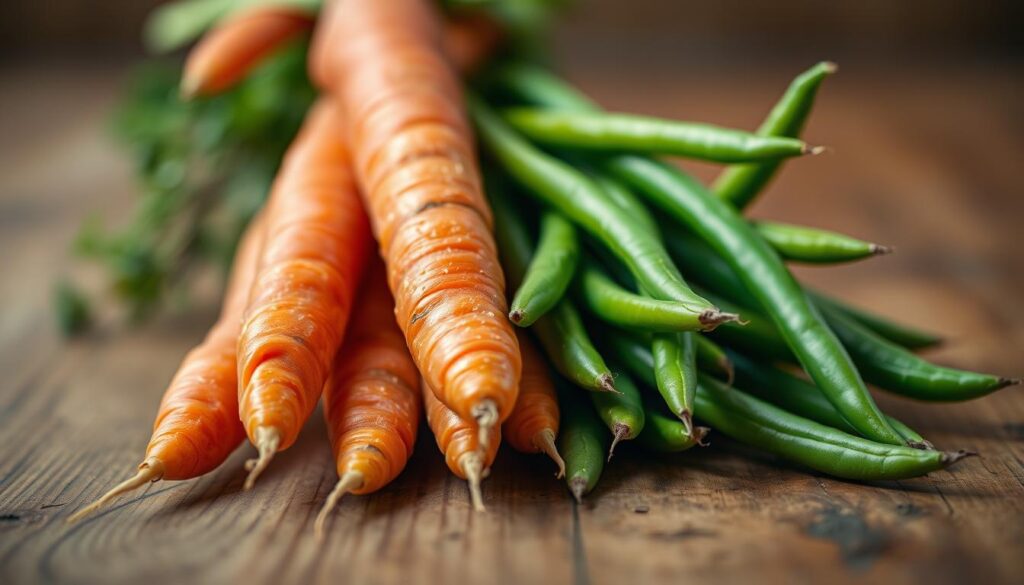
| Vegetable | Flavor Profile | Key Cooking Method |
|---|---|---|
| Carrots | Sweet, earthy | Roasting |
| Green Beans | Fresh, grassy | Steaming |
Healthy Recipes Featuring Carrots and Green Beans
We can easily add carrots and green beans to our meals with quick and healthy recipes. These veggies taste great together and make our dishes look good. Let’s look at some easy cooking ideas, like tasty stir-fries and fresh salads.
Stir-Fry Delights
To make a vibrant stir-fry, sauté sliced carrots and green beans together. Use sesame oil for a nutty flavor and low-sodium soy sauce for a savory taste. Cook for 5-7 minutes, stirring often to keep them crisp yet tender.
Nutritious Salads
For a light dish, try making fresh salads with blanched green beans and shredded carrots. Add halved cherry tomatoes for color and flavor. Then, drizzle with olive oil and lemon juice vinaigrette. This mix is perfect for any meal.
Carrots and Green Beans: A Flavorful Vegetable Duo
Carrots and green beans make a great team in cooking. They add color and crunch to our meals. This duo makes our dishes more exciting.
Carrots are sweet, and green beans are earthy. Together, they offer a mix of flavors and textures. They’re perfect as a side or in a main dish.
Using carrots and green beans in our cooking is good for us. They’re full of nutrients and make our meals healthier. Let’s enjoy the many ways to use this tasty pair.
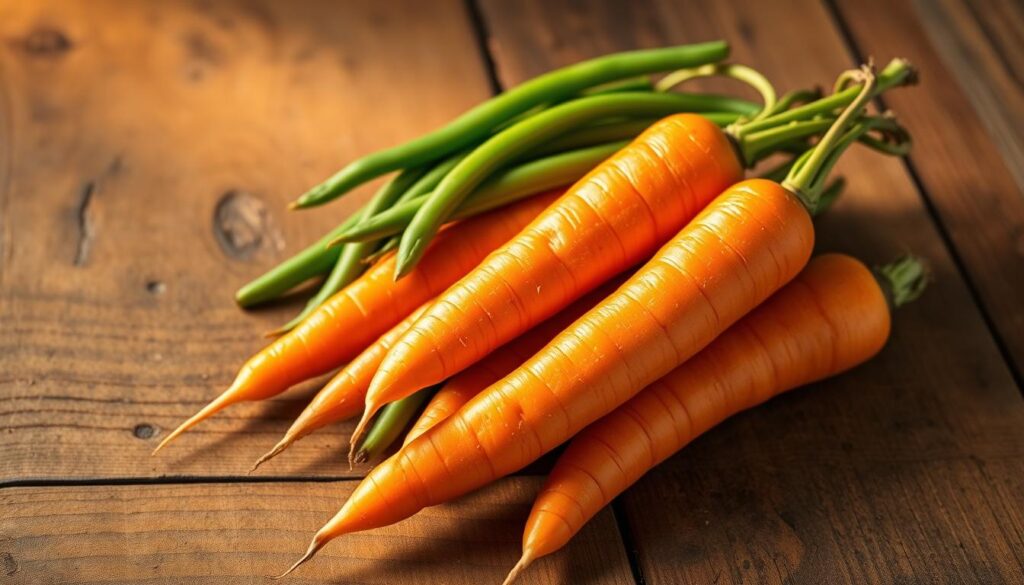
How to Choose Fresh Vegetables at the Market
Going to the market and picking fresh veggies can really improve our meals. Choosing quality carrots and fresh green beans is key. Here are some tips to help you pick the best vegetables.
Identifying Quality Carrots
Quality carrots have firm, smooth skin and a bright orange color. Look for these important signs:
- Firmness: Carrots should feel solid and not yield easily to pressure.
- Color: Bright orange is best; dull or faded carrots are likely old.
- Blemishes: Steer clear of soft spots or discoloration, signs of overripeness.
Spotting Garden-Fresh Green Beans
For fresh green beans, aim for bright green and crisp. Here’s what to look for:
- Color: Choose beans with a vibrant, uniform green color.
- Texture: Beans that snap easily are fresh.
- Length: Medium-sized beans usually taste and feel better.
Incorporating Organic Produce into Your Meals
Adding organic produce to our meals makes them taste better and healthier. Organic carrots and green beans add great flavors. They let us enjoy fresh food without worrying about harmful pesticides.
Choosing organic helps our health and supports green farming. It’s a win-win for everyone.
Here are some easy ways to add organic veggies to your meals:
- Use organic carrots in salads for a crunchy texture and vibrant color.
- Add organic green beans to stir-fries for a nutrient-packed boost.
- Try organic produce in soups to maximize flavor while ensuring your dishes remain wholesome.
Choosing local and organic connects us to our food. It’s good for our taste buds, our communities, and the planet. Cooking with fresh ingredients is a tasty journey with endless possibilities.
The Versatility of Carrots and Green Beans in Culinary Dishes
Carrots and green beans are stars in many dishes, showing their versatility. They add depth and nutrients to soups and stews. They’re essential in vegetable soups and hearty beef stews.
Enhancing Soups and Stews
Chop carrots and green beans into small pieces for soups and stews. Their sweetness pairs well with broth and spices. Simmer them until tender but vibrant.
This way, they keep their shape and health benefits.
Perfect Pair for Sautéing
Carrots and green beans add crunch and color to sautéed dishes. Slice them diagonally for a nice look. Heat olive oil in a skillet, add the veggies, and sauté briefly.
This method keeps them fresh and flavorful. They soak up garlic or herbs well, perfect for quick meals.
Creative Ways to Serve Carrots and Green Beans
We have many ways to add carrots and green beans to our meals. They can become tasty purées and side dishes. These make any meal more enjoyable.
Purees and Baby Foods
For babies, pureed carrots and green beans are a great choice. Just steam them until soft, then blend until smooth. It’s a way to give them important vitamins and new tastes.
As Side Dishes for Meat
Adults can enjoy carrots and green beans as side dishes with grilled chicken or roasted pork. Sauté or steam them, adding salt and olive oil for flavor. It makes the meal colorful and healthier.
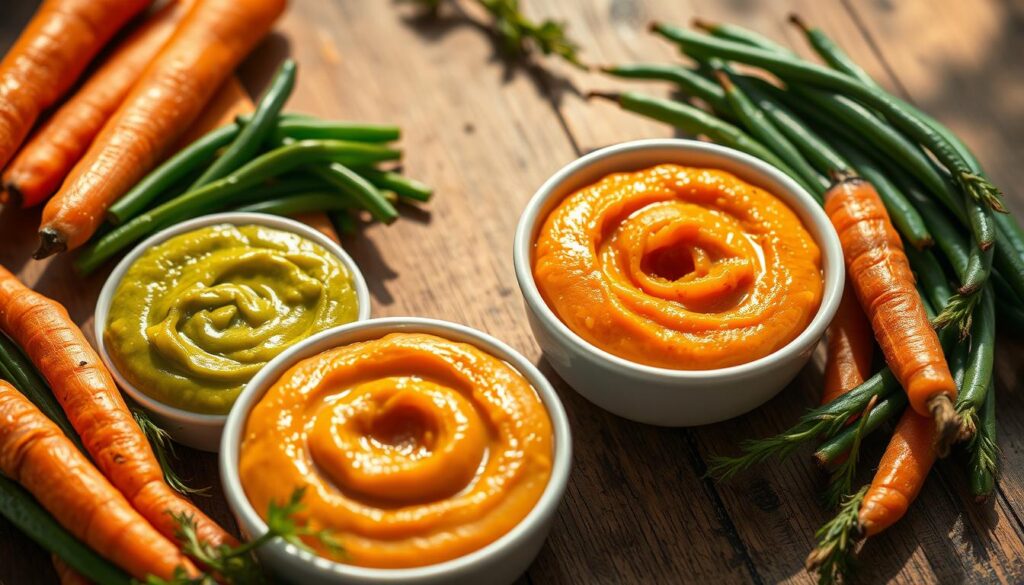
The Environmental Impact of Growing Vegetables
Understanding the environmental impact of growing vegetables helps us make better food choices. Choosing locally sourced carrots and green beans cuts down on carbon emissions from transportation. This choice supports local farmers and brings us fresher produce.
Using sustainable practices in farming is key to protecting our ecosystems. Methods like crop rotation, organic farming, and natural pest control improve soil health and biodiversity. By backing farmers who use eco-friendly methods, we encourage responsible food consumption and a greener food system.
As home cooks, we can choose to support sustainable farming. Growing our own vegetables or buying from local markets strengthens our connection to our food. Every step towards sustainability benefits us now and ensures a healthier planet for the future.
Vibrant Colors: The Aesthetic Appeal of Carrots and Green Beans
Carrots and green beans add a lively touch to our meals. Their bright orange and lush green colors make dishes stand out. They turn simple plates into beautiful culinary experiences.
These colorful vegetables are more than just pretty. They show we’re eating a variety of healthy foods. Adding carrots and green beans to other colorful veggies makes meals both beautiful and nutritious. This way, every meal becomes a feast for the eyes and a chance to enjoy different nutrients.
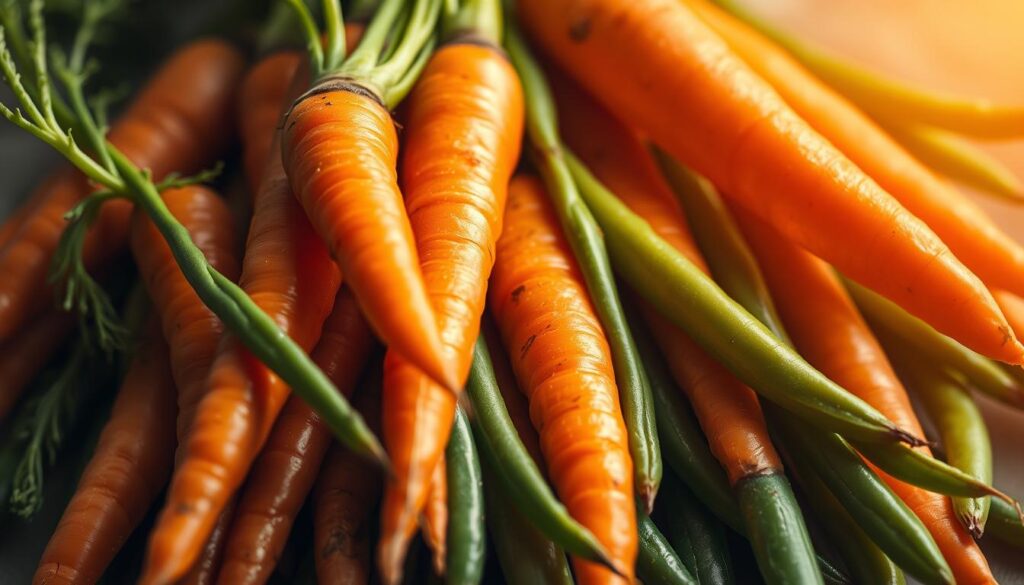
Pairing Carrots and Green Beans with Other Ingredients
Pairing carrots and green beans with other ingredients is an art. By adding herbs and spices, we can make these veggies taste amazing. This makes our meals not only tasty but also healthier.
Complementing Herbs and Spices
Adding fresh herbs and spices can turn carrots and green beans into a feast. Here are some great pairings:
- Parsley: Adds a fresh, mild flavor that brightens up any dish.
- Thyme: Offers a subtle earthiness that complements the sweetness of both vegetables.
- Garlic: Provides a robust flavor that pairs wonderfully with the natural sweetness.
Mixing with Whole Grains
Adding whole grains to your meal makes it complete. Grains like quinoa or brown rice add texture and nutrition. They also bring protein and fiber, making your meal healthier. Here’s a simple comparison:
| Ingredient | Protein (per cooked cup) | Fiber (per cooked cup) |
|---|---|---|
| Carrots | 1 g | 5 g |
| Green Beans | 2 g | 4 g |
| Quinoa | 8 g | 5 g |
| Brown Rice | 5 g | 3.5 g |
This pairing not only nourishes but also adds exciting flavors and textures. It makes every bite a delight.
Health Trends: The Rise of Vegetable-Centric Diets
In recent years, a shift towards vegetable-centric diets has gained substantial momentum. This movement mirrors our growing awareness of health trends that prioritize wholesome, plant-based nutrition. By embracing vegetables like carrots and green beans, we craft meals that are not only delicious but also rich in essential nutrients.
Vegetable-centric diets challenge us to be creative in the kitchen. Meals become a celebration of fresh produce, encouraging experimentation with flavors and textures. With more emphasis placed on whole foods, we nourish our bodies effectively while enjoying every bite.
As we incorporate these nutritious vegetables into our diets, we align ourselves with a broader community focused on healthier eating. Exploring such diets means supporting local farmers and engaging with seasonal produce. Cooking with vegetables allows us to connect with our food, making our cooking experiences more enjoyable.
Gardening Tips for Growing Your Own Carrots and Green Beans
Want to grow carrots and green beans? Start with the basics. Know your soil well. Both veggies love well-drained soil with organic matter. Planting at the right time is key for a good harvest.
Soil Requirements and Planting Seasons
For healthy carrots and green beans, focus on these:
- Soil type: Loamy or sandy soil works best.
- pH level: Aim for a pH between 6.0 and 7.0.
- Organic matter: Incorporate well-rotted compost to enhance nutrient availability.
Planting seasons matter too. Carrots do well in early spring. Green beans love the warmth of late spring. Planting at the right time means a better harvest.
Pest Management Techniques
Keeping pests away is vital. Watch your garden closely to catch problems early. Here are some tips:
- Use companion planting to deter pests naturally.
- Employ organic methods like neem oil or insecticidal soap.
- Regularly check for signs of infestation and take immediate action if needed.
By following these tips, we can grow plenty of carrots and green beans. Enjoy fresh flavors from your own garden.
Conclusion
We celebrate the great taste and health benefits of carrots and green beans together. They make our meals better. By trying different cooking methods, like roasting or steaming, we can enjoy them often.
This journey into cooking with these veggies helps us value good nutrition. It shows us how important healthy eating is.
Knowing when they’re in season helps us use them at their best. This makes our meals not only tasty but also healthier. There are many recipes out there, so we can always find new ways to enjoy them.
Let’s keep exploring the world of vegetables. Making healthy eating fun and tasty helps us love cooking more. And it brings us many benefits from eating more veggies.

